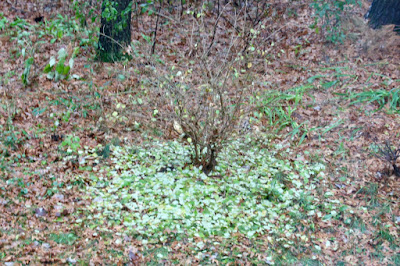 |
| and then there were none
Photo by J. Harrington
|
Several of our bushes held onto their leaves until very recently, and then they dumped all of them at once. We're not sure if this is typical of these plants (we don't remember noticing a similar pattern last year) or if it's attributable to some quirk in this Autumn's weather. We are reasonably certain that all the leaves on these particular bushes came down concurrently because it's been windy enough that an extended leaf fall would have resulted in more scatter. One of the bushes that held its leaves, and still is covered in green leaves, is a forsythia we've had for several years that has now started to imitate a buckthorn.
 |
| persistent forsythia right center
Photo by J. Harrington
|
The maples this year didn't really develop the colors we've come to expect. Oaks, being oaks, will continue to drop leaves a few at a time until next Spring. Local tamaracks are almost all down to bare branches. With the recent snows almost all melted, the still green buckthorn doesn't stand out quite as much as it did when the ground was covered with snow that contrasted the green leaves. Would herds of feral goats create more problems than they solve? Any chance we could train or genetically modify whitetail deer to eat buckthorn? Too often, when we start thinking silly like this, we try to remember the following anecdote from Natural Capitalism:
"Consider what happened in Borneo in the 1950s. Many Dayak villagers had malaria, and the World Health Organization had a solution that was simple and direct. Spraying DDT seemed to work: Mosquitoes died, and malaria declined. But then an expanding web of side effects (“consequences you didn’t think of,” quips biologist Garrett Hardin, “the existence of which you will deny as long as possible”) started to appear. The roofs of people’s houses began to collapse, because the DDT had also killed tiny parasitic wasps that had previously controlled thatch-eating caterpillars. The colonial government issued sheet-metal replacement roofs, but people couldn’t sleep when tropical rains turned the tin roofs into drums. Meanwhile, the DDT-poisoned bugs were being eaten by geckoes, which were eaten by cats. The DDT invisibly built up in the food chain and began to kill the cats. Without the cats, the rats multiplied. The World Health Organization, threatened by potential outbreaks of typhus and sylvatic plague, which it had itself created, was obliged to parachute fourteen thousand live cats into Borneo. Thus occurred Operation Cat Drop, one of the odder missions of the British Royal Air Force."
A Short Story of Falling
By Alice Oswald
It is the story of the falling rain
to turn into a leaf and fall again
it is the secret of a summer shower
to steal the light and hide it in a flower
and every flower a tiny tributary
that from the ground flows green and momentary
is one of water's wishes and this tale
hangs in a seed-head smaller than my thumbnail
if only I a passerby could pass
as clear as water through a plume of grass
to find the sunlight hidden at the tip
turning to seed a kind of lifting rain drip
then I might know like water how to balance
the weight of hope against the light of patience
water which is so raw so earthy-strong
and lurks in cast-iron tanks and leaks along
drawn under gravity towards my tongue
to cool and fill the pipe-work of this song
which is the story of the falling rain
that rises to the light and falls again
********************************************
Thanks for visiting. Come again when you can.
Please be kind to each other while you can.
No comments:
Post a Comment